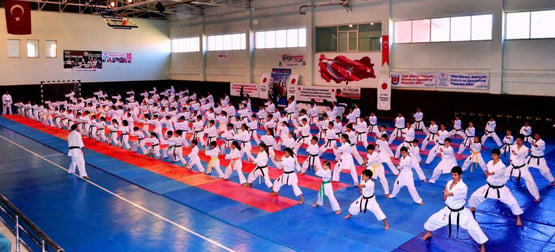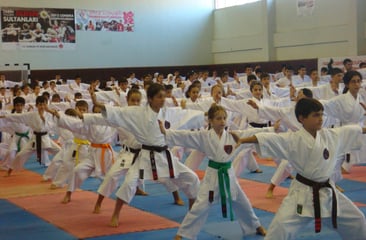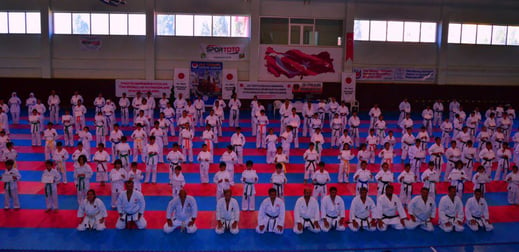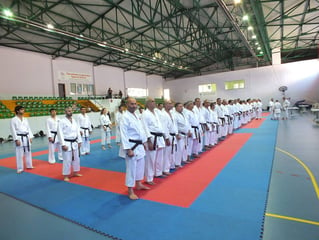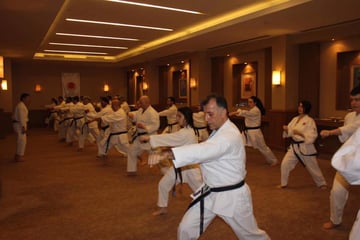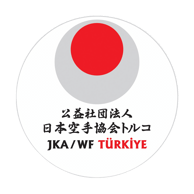The martial art known as "Kara" (empty) - "Te" (hand) was developed in Okinawa as a self-defense system. Due to Okinawa's frequent communication and trade with China, Okinawan martial arts were influenced by Chinese Kempo at certain points during their development. However, because there are no official and current records beyond oral traditions, the exact time when the art adopted the name Kara-Te is not known. It is believed that the development of Kara-Te began around five hundred years ago when King Shoha, after uniting his country following centuries of warfare, issued a decree prohibiting the ownership of weapons.
HISTORY OF THE JAPAN KARATE ASSOCIATION (JKA)
According to traditional accounts, a similar decree prohibiting the use and ownership of weapons was reissued by the Satsuma Clan. This clan invaded Okinawa in the early 1600s and brought it under the control of the Japanese Shogunate. It is believed that under these conditions, Kara-Te was secretly developed as an unarmed combat model for people to protect themselves and their country. Later, Okinawan Kara-Te master Funakoshi Gichin was born in 1860. He devoted his entire life to developing the values of the Kara-Te art and introduced Karate-jutsu across the country. In 1949, to further develop Kara-Te, followers of Master Funakoshi Gichin established the Nihon Karate Kyokai, or the Japan Karate Association
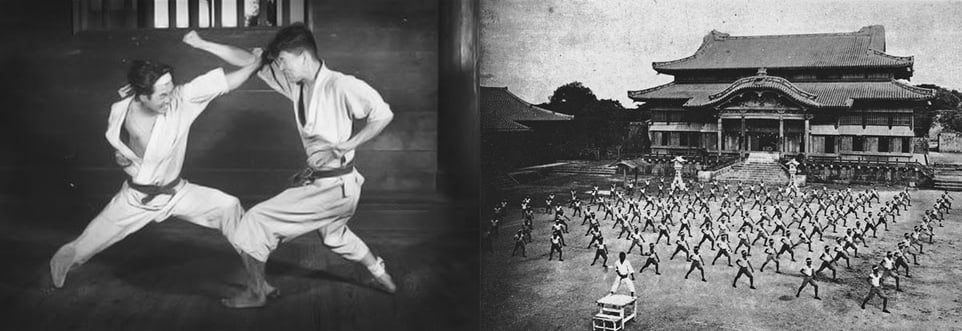

The JKA was established in May 1949. In 1955, the first central dojo was built in Yotsuya, Tokyo, and Saigo Kichinosuke, the grandson of Saigo Takamori, a member of the Japanese Upper House and a great hero of Meiji Japan, was appointed as the first president. In 1956, JKA launched the first karate expert instructor training program (kenshusei) at the central dojo and accepted its first batch of students. This marked the beginning of a unique karate instructor training program.
Through this program, JKA formed a distinguished team of elite karate instructors, consisting of around twenty full-time, salaried professionals.
On April 10, 1957, with the goal of advancing, spreading, and enriching true karate education, JKA was officially recognized as a legal institution by the Japanese Ministry of Education (now the Ministry of Education, Culture, Sports, Science and Technology). Twenty years later, with the support of an individual foundation, another karate organization aimed at organizing karate competitions also gained legal status.
About two weeks after JKA achieved legal status, the great master Funakoshi passed away at the age of 89. After nearly a decade, an era had ended, but the true development of Karate was just beginning.
THE EARLY YEARS (1949-1957)
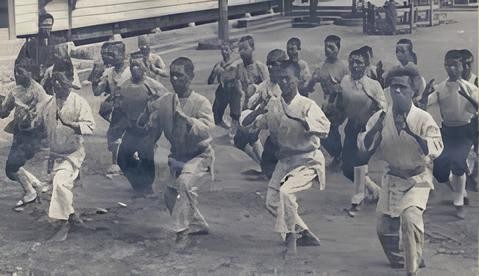


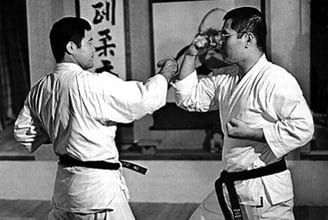
GROWTH AND DEVELOPMENT (1957-1989)
The popularity of Karate continued to grow. In 1957, the first JKA All Japan Karate Championship was hosted in Tokyo. This first tournament, which applied rules to karate matches, was limited to four categories: individual men's kumite and kata, and men's team kumite and kata. After the tournament was officially established as an annual event, JKA branches quickly expanded throughout Japan, reaching city centers, schools, and around forty leading universities. In 1958, Master Nakayama began his role as chief instructor.
In 1961, His Majesty the Japanese Prince (now His Majesty the Emperor of Japan) participated in the 5th JKA All Japan Karate Championship. Karate was beginning to gain recognition. Over the years, the tournament expanded to include new categories, such as university divisions (1969), women's kata (1974), a youth category within the general division (1975), a completely separate youth category covering elementary, middle, and high schools, and women's kumite (1985). As a result, the number of participants grew exponentially.
During this period, JKA developed the karate training system, significantly expanding its organization by opening new dojos across Japan. Starting from the early months of 1958, JKA achieved great success and sent professional instructors to America, Europe, and the Middle East, enabling them to teach and establish new dojos in these regions. As a result, Karate gained significant attention and success outside of Japan.
In 1975, and in the following three years, the United States hosted the first international tournament sponsored by JKA, the International Amateur Karate Federation World Cup (IAKF), with the prospect of Karate’s potential inclusion in the Olympics. However, in order to preserve the true technique and spirit of Karate, known as ippon-shobu (defeating the opponent with a single strike), JKA organized a new tournament called the Shoto World Cup Karate Championship. In 1985, Japan hosted the first International Shoto World Cup, witnessing Karate’s transformation into an international art form.
This period witnessed the remarkable development of the art of Karate. As a result of ongoing training among instructors, Karate techniques became a complete system. For the first time, kumite stances and movements took on their most precise, scientific, and practical form. Additionally, clear definitions and descriptions of the correct and incorrect ways to perform stances, punches, kicks, and techniques emerged. As these techniques developed, many instructors traveled overseas to spread the art of Karate.
JKA became the first karate organization to establish dojos outside of Japan. This made JKA an extremely prestigious and powerful organization worldwide. Moreover, JKA became the only Karate organization to send qualified and fully authorized instructors to universities to teach Karate. In 1986, the distinguished businessman and member of the Tokyo University Karate Club, Nakahara Nobuyuki, was appointed as the eighth president of JKA. Unfortunately, as Karate reached its peak, Master Nakayama passed away at the age of 74 in 1987.
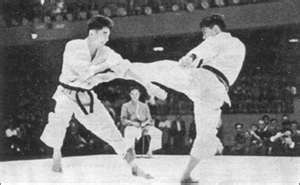

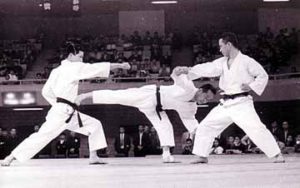

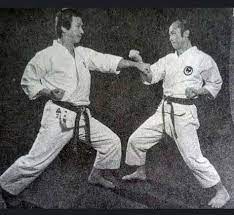

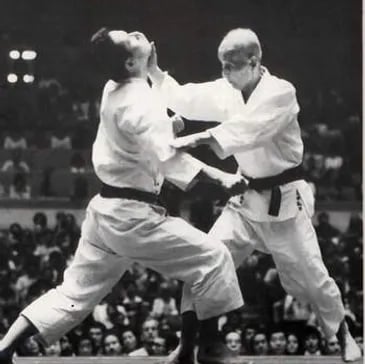

In 1990, JKA experienced a crisis when a group within the organization attempted to take over its official status. This group convened an extraordinary general assembly but did not officially state its agenda or purpose. After this unlawful meeting, the group succeeded in changing the leadership, leading to a lengthy legal battle.
Despite these events, JKA continued to grow. The overwhelming majority of instructors and members remained loyal to the true JKA. Master Sugiura Motokuni was appointed as chief instructor in 1991. Together with President Nakahara, they initiated a return to the true spirit of Karate at a time when this spirit was most needed. In 1994, JKA published five authorized kata training books, which quickly became the sacred texts of Karate kata.
The court rulings were eventually announced. In 1995, as members had long awaited, JKA won the case in the Tokyo District Court. In 1998, the decision was upheld by the Tokyo High Court. Then, in June 1999, the Japanese Supreme Court rejected the group’s attempt to reopen the case, permanently closing it. As a result, the management unlawfully taken by the breakaway group was returned to its rightful owners. Ultimately, JKA not only overcame these challenges but emerged from this struggle even stronger, gaining a stronger sense of commitment and identity than ever before.
OVERCOMING CHALLENGES (1990-1999)
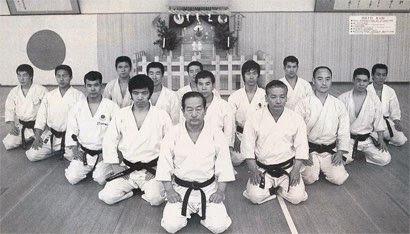

JKA STEPS INTO THE 21ST CENTURY
With the restoration of its legal status through court decisions, JKA made a significant leap into the 21st century. It reorganized its internal structure and financial setup. In November 2000, JKA purchased land in the center of Tokyo and established a brand-new central dojo. This marked the first time that JKA owned its own land and building. In May 2001, a grand opening ceremony was held with the participation of other Karate organizations and external guests.
With its renewed energy, JKA clearly identified itself as "The Protector of Karate's High Tradition." In 2004, with the aim of taking true Karate to a higher level and spreading it worldwide, JKA launched its official website.
The Japan Karate Association (JKA) was an organization founded in 1948 as a non-profit entity. In 1957, due to its numerous activities and unique contributions to society, JKA was officially recognized by the Japanese Ministry of Education as a SHADAN HOJIN (corporate body). Due to the ongoing contributions and benefits to society, JKA was officially recognized by the Japanese government on March 21, 2012, as KOEKI SHADAN HOJIN (public interest incorporated organization). JKA is the only martial arts organization to hold this designation.
JKA aims to contribute to world peace by: 1. Conducting research on Karate-Do and providing training, 2. Influencing children and young people by combining their physical and mental development with the spirit of martial arts, and 3. Expanding the concept of Japanese Martial Arts, which emphasizes respect and discipline, to a wide audience.
JKA members strive to develop their character and contribute to society. This is the true value of Karate-Do as a martial art and the mission of JKA. JKA takes this responsibility seriously and constantly seeks to contribute to society through various activities.
